|
|
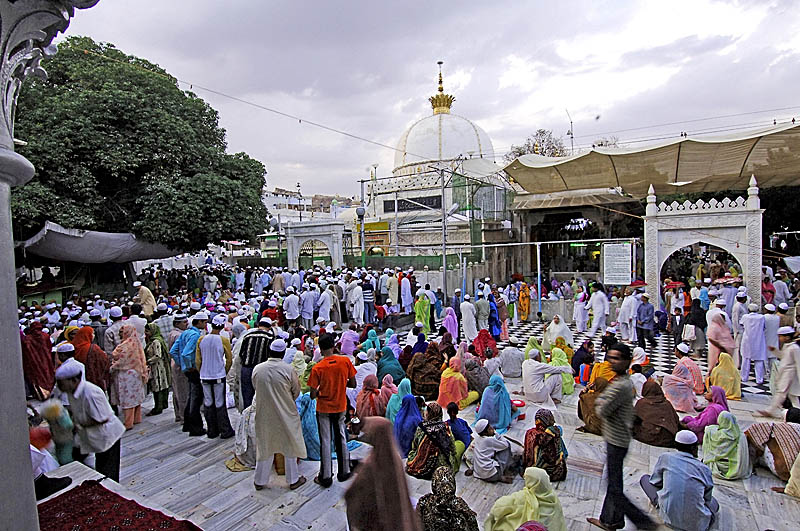
|
Ajmer Urs,
Ajmer |
|
Introduction of Ajmer
Urs |
|
URS
FESTIVAL AT AJMER SHARIF IN RAJASTHAN, INDIA
Ajmer of Rajasthan in India is recognized as a holy place for both
Hindus and Muslims. Ajmer has the tomb of the Sufi saint, Khwaja
Moinuddin Chishti, whose blessings are excitedly required by pilgrims
to his Dargah known as the ĎDargah Sharif. The saintís marble domed
tomb is Indiaís most important shrine for Muslims and receives an
endless flow of visitors of all religions as the sick, the troubled
and the childless come here seeking a boon, a blessing or just peace
of mind. Legend has it that the Mughal emperor, Akbar came here to the
saint in the 16th century in seek of a help for a successor and the
saint obliged.
The Urs festival or annual pilgrimage of the religious is celebrated
each May at the Dargah with millions of pilgrims arriving in Ajmer to
pay respect. The Urs festival, a memorial celebration is held in the
solemn memory of Khwaja Moinuddin Chisti, a brightly respected sufi
saint fondly respected as the supporter of the poor, popularly known
as Gareeb Nawaz. The Khwaja left for lovely dwelling in 1256 AD after
a six day prayer in privacy. These six days are celebrated every year
as the annual Urs, which is attended by countless pilgrims
irrespective of their faith. The shrine is well thought-out to be a
place of wish fulfillment for those who pray with devoted and pure
hearts. Lengthy queues of numerous kilometers bend their way past the
tomb at the shrine. Within the dargah lies a mosque, constructed by
the Mughal Emperor Shah Jahan. Like all of Shah Jahanís buildings, the
mosque too, is an architectural miracle - a wonderful building in
white marble with a long and narrow courtyard for the faithful to pray
in, richly embellished with elaborate calligraphic inscriptions, weak
carvings and detailed trelliswork.
Chadar; Ghilaph & Neema which are votive contributions for the tomb
are offered by numerous hundred thousand devotees. Mehfils & Qawwalis
are held and mass prayer calls for the everlasting peace of the
mankind. An exciting ceremony is the looting of Kheer (Milk Pudding)
which is cooked in two big cauldrons called Degs and distributed to
the devotees as tabarruk (blessed food).
|
|
Rituals of Urs at Ajmer Sharif in Rajasthan, India |
|
The
pilgrims who come to look for the blessings of the Khwaja make some
offerings called nazrana at the holy spot where the saint has been
entombed. The gifts of perfumes and incense, sandalwood paste, rose
and jasmine flowers, contribute to the fragrance that floats in the
air inside the shrine.Chadar, Ghilaph and neema are also offered by
devotees which are votive contributions for the tomb.
These all things are handed over to the khadims inside the holy place
sanctorum and these things are brought by devotees on their heads.
Specialized singers called Qawwalis in groups and sing the praises of
the saint in a typical high pitched voice at Outside of the holy place
sanctorum of the dargah,. People pay attention carefully and assemble
around them and, sometimes clapping to the tempo of their instruments.
The Urs festival at Ajmer Shariff is initiated with the hoisting of a
white flag on the dargah by the Sajjada Nashin (successor
representative) of Chistis. It is done on the 25th of Jamadi-ul-Akhir
(sixth lunar month), with the addition of music. The Jannati-Darwaza
(gateway of heaven) is flung open early in the morning on the last day
of the sixth month,. People cross this gate seven times with the faith
that they will secure a position in heaven. The tomb is cleaned with
rose water and sandalwood paste and anointed with perfumes On the 1st
of Rajab,. This ritual is called ghusal. The tomb is then enclosed
with an embroidered silk cloth by the Sajjada Nashin.
The looting of kheer (milk-pudding) which is cooked in two huge
vessels called degs is an exciting ritual which were donated by
Emperor Akbar and distributed to the devotees as tabarruk (blessed
food). On the 6th of Rajab. The Sajjada Nashin performs the ghusal of
the tomb after the normal mehfil and the noise of cracker-bursts
accompanied by music. Fatiha and Salamti are read. A poetic narration
called mushaira is set in which poets of all communities get there to
narrate compositions committed to the Khwaja. The Qul (end-all) on the
6th of Rajab marks the end of the Urs.
Religious assemblies called mehfils are held in the mehfil-khana at
night, which is a big hall intended for this idea. Sajjada Nashin of
the dargah conducts these. The hall is packed to capacity and the
Qawwalis are sung. Separate places are reserved for the women who
attend the mehfil. With a mass prayer for the endless peace of the
Khwaja in particular and mankind in common the mehfil finishes late in
the night.
|
|
History and Legend of Urs at Ajmer Sharif in Rajasthan, India |
|
The
Dargah Sharif in Ajmer of Rajasthan is the place where the Saint's
mortal remains lie buried and is the site of the largest Muslim fair
in India. More than five lakh devotees belonging to diverse
communities assemble from all parts of the subcontinent to pay homage
to the Khwaja on his Urs (death anniversary) throughout the first six
days of Rajab (seventh month of the Islamic calendar).
The lakeside city of Ajmer is positioned in central Rajasthan in
India, and is held in great respect by devotees of all communities who
name it 'Ajmer Sharif' (Holy Ajmer). It is here that the mortal
remains of the highly appreciated Sufi saint Khwaja Moin-ud-din
Chishti lie covered.
The Khwaja came from Persia and established the Chishtia order of
fakirs in India. He is commonly recognized as Gharib Nawaz (protector
of the poor) because he devoted his whole life to the service of
mankind. His economical life covers about hundred years and he
embraced death in emptiness while he had withdrawn to his cell for six
days, asking not to be disturbed.
|
|
Other Attractions of Ajmer in Rajasthan, India |
|
Ajmer of Rajasthan is well known for Adhai - din - ka - jhonpra, Akbar
Palace of Rajasthan, Nasiyan Temple and several more like Anna
Sagar.Anna Sagar is the artificial lake which was formed in the 12th
century by damming the River Luni. Daulat Bagh, on the banks of the
river contains a sequence of marble pavilions raised in 1673 by
Shahjahan. Alongside the Daulat Bagh there are fine scenes from the
hillside. Jetty and paddleboats can be hired At Ana Sagar. The lake
opts to dry up if the monsoon is poor, so the city's water supply is
taken from Foy Sagar, 3 km farther up the valley.
|
|
Location and Transport of the Ajmer Sharif in Rajasthan, India |
|
The
Dargah of Ajmer Shariff is positioned at the conjunction of three
bazaars. There are lots of restaurants around the Dargah where
visitors can select from a variety of dishes most of the dishes are
non-vegetarian. Guest houses on the road leading to the Dargah offer
accommodation that ranges from economical to luxurious. Several other
guest houses are spread across the city. The shops in the market in
the region of the Dargah sell flowers, prayer mats, rosaries,
textiles, and also general merchandise.
Ajmer is 132 km south-west of Jaipur and 198 km east of Jodhpur.
Ajmer By Rail
Ajmer of Rajasthan is a railway junction on the Delhi-Ahmedabad
section of the Western Railway. Ajmer of Rajasthan is very well
connected by train; there are frequent (in many cases daily) trains to
and from the city to other destinations in India, including Delhi,
Mumbai and Jaipur of Rajasthan. Delhi is linked to Ajmer of Rajasthan
by the fast Shatabdi Express, easily the quickest and most relaxed way
of getting to Ajmer. Shatabdi connects Ajmer to Delhi. Shatabdi is
completely air conditioned train starts from Delhi (5.55 AM) to Jaipur
of Rajasthan (10.35 AM).
Ajmer By Road
A good national and state highway network connects Ajmer of Rajasthan
to further parts of Rajasthan and a lot of significant cities in
India. Hired transport is simply available, be it cars, jeeps,
minibuses or SUV's and almost all come with qualified drivers. State
and interstate roadways buses, RTDC conducted tours and coaches link
Ajmer to most vital cities in the region, together with Ahmedabad,
Jaipur of Rajasthan, Udaipur of Rajasthan, Jodhpur of Rajasthan,
Bikaner of Rajasthan, Mt. Abu of Rajasthan, Jaisalmer of Rajasthan,
Mumbai and Delhi. During the Urs of Ajmer Sharif, particular buses ply
from cities all over India carrying people to Ajmer of Rajasthan and
back.
Ajmer By Air
Although Ajmer of Rajasthan does not have an airport of its own, there
is an airport at Jaipur of Rajasthan (130 km away), from where
habitual buses and taxis come to Ajmer of Rajasthan. Indian airlines,
Jet airways and other airlines have usual service to Jaipur of
Rajasthan. All the most important cities are connected to Jaipur of
Rajasthan by air.
Local Transport of Ajmer
Within the city, rented cars, local buses, auto-rickshaws and cycle
rickshaws are the means of transport are available.
|
|
|
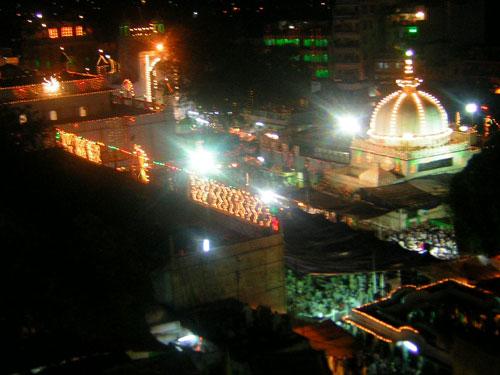 |
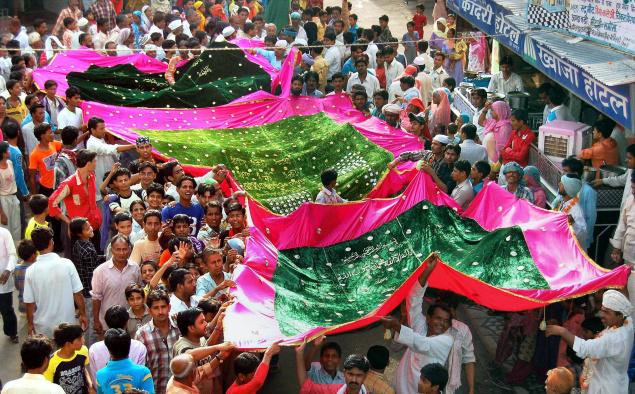 |
|
Khwaja
Garib Nawaz |
Khwaja Garib-e-Nawaz |
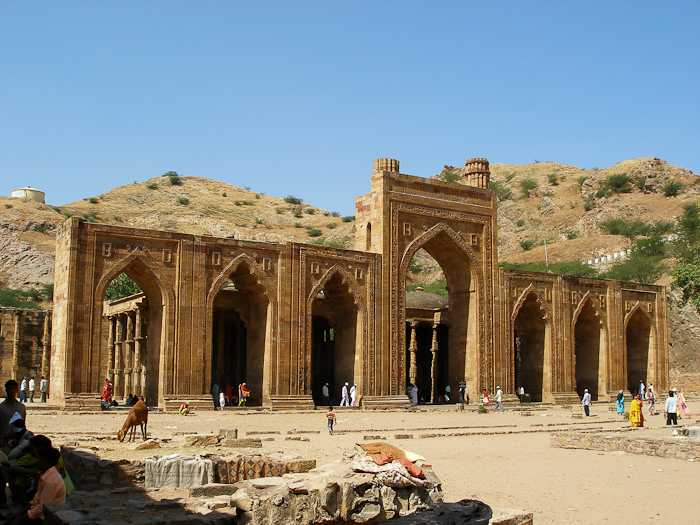 |
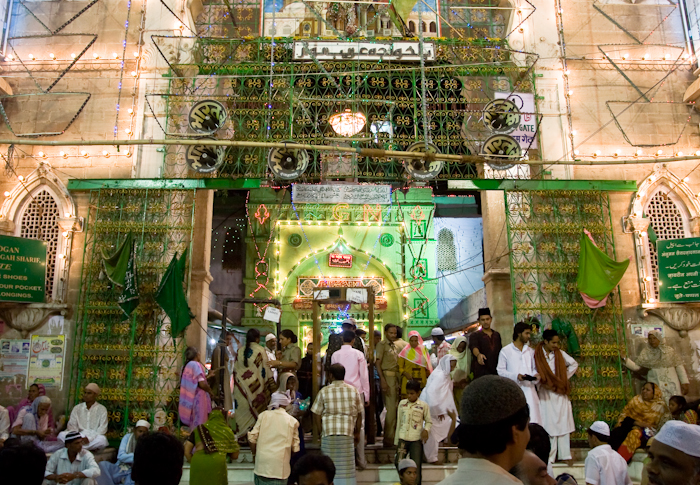 |
|
Adhai Din Ka Jhopra |
Ajmer Urs
Celebration |
|
|
|
|
|
|